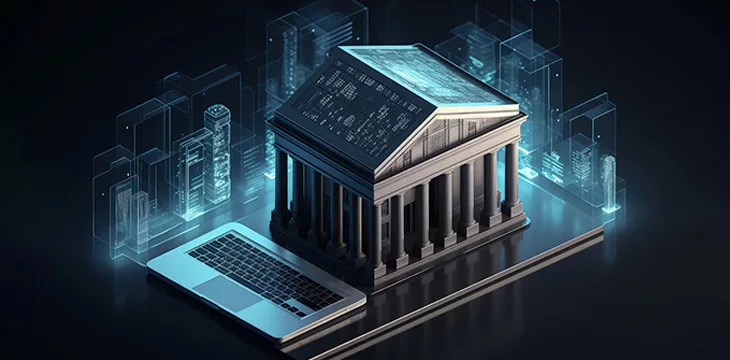|
Getting your Trinity Audio player ready...
|
Digital assets players are having to turn to non-banking financial institutions, so-called ‘shadow banks,’ in the wake of tech bank collapses, increasing the potential for a contagious crisis.
The recent collapse of the tech banks Silicon Valley Bank (SVB), Silvergate Capital (NASDAQ: SI), and Signature, all in the space of a few weeks, has left many digital asset players looking for alternative banking and finance partners.
With traditional banks less than welcoming to the industry, it’s being increasingly pushed into the open arms of the shadow banking sector. As described by a February 2023 report by Corporate Finance Institute (CFI): “Many legacy financial institutions remain reluctant to provide financing for digital assets as collateral. Hence, speculators and investors are resorting to shadow banking cryptocurrency firms and exchanges to provide leverage.”
According to the CFI, shadow banks can be described as “the broad collection of financial institutions and financial markets that offer the same type of services as commercial banks but that are not within the regulatory environment that traditional banks are subject to.”
The distinction matters because traditional banks are regulated to ensure their stability and protect depositors and the financial system from risks associated with banking activities, including fraud and financial instability. These safety measures are necessary because of the importance of banking to the broader economic system—both to businesses and individuals—and the risk to financial stability if things go wrong.
On the other hand, the shadow banking system has escaped regulation primarily because, unlike traditional banks and credit unions, these non-bank financial institutions are not allowed to take traditional demand deposits—readily available funds, such as those in checking or savings accounts—from the public. Because they do not take deposits from the public and do not hold depositors’ money, they are not subject to the same regulations that apply to banks, such as deposit insurance and reserve requirements.
Raffaella Calabrese, Personal Chair of Data Science and Director of the Fintech PhD and the Banking and Risk Programmes at the University of Edinburgh, speaking with CoinGeek, suggests that the digital asset industry is largely moving towards shadow banking by default rather than choice.
“It would be easier and preferable to get funding from traditional banks, it’s just that they don’t have access,” says Calabrese. “Innovative products are classified as high-risk for traditional high street banks, so they don’t provide enough funding, which is why they’re moving towards shadow banking.”
As shadow banking becomes increasingly prevalent and widely utilized as a banking alternative for digital asset companies, it begins to become more systemically important, taking on some of the greater contagion risks associated with traditional banking—but without any of the safeguards.
This is compounded by the fact that the digital asset industry is another space where regulation is often lacking or playing catch-up, and can be prone to contagion effects when a problem occurs. 2022 provided plenty of evidence of the domino effects that can occur in the interconnected ecosystem, TerraUSD and FTX being the most prominent examples.
The systemic risk posed by shadow banking entities is not a new phenomenon. The market crash of 2008 laid bare the risks a highly interconnected and poorly regulated market can pose.
In 2008, traditional banks began the securitization of risky mortgage loans. They packaged and sold mortgage-backed securities (MBS), transforming mortgages into tradable securities, which were then sold off to shadow banks, increasing the interconnectedness between the two sectors in the process. Shadow banks often financed their purchases of MBS by borrowing money through short-term funding sources, such as repurchase agreements and other forms of leverage. This allowed them to up their investments and their exposure to MBS.
In this way, shadow banking entities fueled the subprime mortgage boom through their risky lending practices, which included excessive securitization and creating complex financial products that spread risk throughout the financial system, ultimately leading to a global financial crisis. But unlike traditional banks, shadow banks couldn’t turn to the Federal Reserve for a bailout when the market plunged.
As Calabrese points out: “Comparing the regulation of shadow banks with traditional banking, it’s obvious that in 2008 shadow banking had a contagion effect because it’s less regulated, and this risk is getting worse.”
The reason the risk could be getting worse, suggests Calabrese, is a combination of the increasing value of the digital assets industry, the interconnectedness of the market, and the lack of regulation governing shadow banking.
With this kind of track record, should the digital asset space be increasingly exposing itself to another potentially at-risk sector?
What they do in the shadows
Exactly what constitutes a bank varies from jurisdiction to jurisdiction. Generally, banks take deposits from the public, provide money-related service, and are required to hold a license to operate.
For example, in the U.K., the term “bank” is defined by the Financial Services and Markets Act 2000 (FSMA) as a credit institution that accepts deposits or takes part in the business of banking that is authorized by the Prudential Regulation Authority (PRA) and regulated by the Financial Conduct Authority (FCA) and PRA. So, it is based on the institution’s activities, authorization, and adherence to regulatory requirements.
The PRA’s regulatory authority does also extend to certain types of shadow banking entities, such as non-bank lenders and investment firms, with the level of regulation and supervision varying depending on its assessment of the entity’s systemic risk, but many entities do not meet this assessment; its primary focus is traditional banking.
In the U.S., a bank is typically defined as a trust company incorporated and doing business under the laws of the U.S., exercising fiduciary powers similar to those permitted to national banks, and with a substantial part of the business being the receiving of deposits and making of loans.
Banks are subject to the U.S.’ strict regulatory regime and must comply with a range of laws and regulations, including the Bank Secrecy Act, the Patriot Act, the Community Reinvestment Act, and the Dodd-Frank Wall Street Reform and Consumer Protection Act. Banks are variously monitored by the Federal Reserve System, the Office of the Comptroller of the Currency (OCC), the Federal Deposit Insurance Corporation (FDIC), the Consumer Financial Protection Bureau (CFPB), and the National Credit Union Administration (NCUA).
These regulations and their governing authorities require traditional banks to comply with stringent anti-money laundering, consumer protection, KYC (know your customer), and capital requirements. Importantly, they do not cover non-bank financial institutions or shadow banks.
Shadow banking institutions, by contrast, arose in the 80s and 90s as innovators in financial markets, financing lending for real estate and other purposes. With the growth of securitization, they became more prominent in their role in turning home mortgages into securities. These instruments allowed banks to transfer credit risk off their balance sheets, but this just transferred the risk to emerging and unregulated non-bank financial institutions.
The 2008 financial crisis exposed this risk, as the failure of several non-bank financial intermediaries triggered a freeze in the credit markets and threatened the stability of the broader financial system.
This precipitated one key piece of legislation that does touch both areas, and yet serves as another example of the distinction in regulation governing traditional banks and their shadowy cousins: the Dodd-Frank Wall Street Reform and Consumer Protection Act. Signed into law in 2010 by President Obama, it came about as lawmakers sought to increase regulatory oversight of the banking industry in the wake of the 2008 crash. The focus was primarily on increasing the security of traditional banks, where the greatest systemic risk lies, but shadow banking was also addressed.
A key feature of the act was establishing the Consumer Financial Protection Bureau (CFPB) as the primary regulator of consumer financial products, and the Financial Stability Oversight Council (FSOC), which was charged with identifying and monitoring systemic risks to the U.S. financial system. The FSOC has the authority to designate non-bank financial companies – such as those providing shadow banking services, as systemically important financial institutions (SIFIs), which subjects them to additional regulation and oversight by the Federal Reserve.
If shadow banks were classified as SIFIs, they would be subject to obligations more akin to the traditional banking sector, including higher capital requirements, periodic stress tests, and the need to produce “living wills” – a description of a company’s strategy for orderly resolution if it comes under financial distress or fails.
However, which entities fall under the SIFI definition has been a source of some contention in Washington DC. Initially, financial institutions with more than $50 billion in assets were labeled as systemically important. However, in 2018, following complaints from smaller banks struggling to handle the costs of complying with enhanced regulation, former President Donald Trump signed a partial rollback that increased the SIFI threshold to $100 billion, and then all the way up to $250 billion 18 months later.
This means that one of the few pieces of legislation imposing significant oversight on the shadow banking space in the U.S. was substantially watered down, leaving the sector essentially in the regulation-lite situation it was in before 2008.
A marriage of inconvenience
Owing to the nascence of the digital asset industry, shadow banks have been a key part of its early development. Some firms use shadow banking because it’s less regulated than traditional finance, having no desire or ability to jump through the compliance hurdles required by regulated banking institutions, but many above-board digital asset firms are simply forced to use shadow banking because traditional banks won’t work with them.
An example can be seen in Bitfinex. In 2017, Wells Fargo and its main Taiwanese banks cut off services to the exchange and left it scrambling for banking options as it struggled to facilitate customer deposits and withdrawals. As a result, Bitfinex increasingly relied on third-party providers to carry on business. One of these providers was Crypto Capital Corp (CCC), a payment processing company registered in Panama, a jurisdiction known for its flexible financial regulation. In 2017, CCC served many of the industry’s biggest names, including BitMEX, QuadrigaCX, and Kraken. Bitfinex would plough over $1 billion through CCC despite the parties having never signed a formal agreement.
This eventually blew up in the face of Bitfinex: at some point, CCC stopped processing payment requests for Bitfinex. CCC claimed to Bitfinex that the funds had been seized by authorities in Poland, Portugal, and the U.S. in connection with an international anti-money laundering and fraud investigation, while Bitfinex appeared to believe that the Panamanian firm had absconded with the funds. CCC’s top two executives – Ivan Manuel Molina Lee and Reggie Fowler – were eventually arrested in 2019: Molina in Poland for money laundering and Fowler for bank fraud and wire fraud in the U.S.
Bitfinex lost access to $850 million in customer funds as a result. To survive, Bitfinex had to borrow $550 million from its sister company, Tether – a loan which sparked an investigation by the New York Attorney General and cast doubt on the solvency of its sister company, Tether.
Part of the problem is that digital assets still occupy a confusing position in the legal landscape, with major jurisdictions only recently introducing comprehensive legislation aimed at addressing digital assets, with debates ongoing. The U.S. is still debating which of the many potential approaches should be chosen in regulating the industry, and the European Union just finalized its Markets in Crypt Assets (MiCA) regulation, which will bring a comprehensive regulatory framework for crypto-assets and related activities within the EU, but not before 2024.
With this uncertainty, legacy financial institutions remain reluctant to serve the industry.
Calebrese suggests a lack of understanding from traditional banking of the risks is exacerbating this situation:
“With digital assets, there is a big variety, you need to provide definitions. There is some progress on this, but I think it is going to take 10-20 years, and in the meantime, we’re going to have problems because we still don’t know all the risks related to these assets, and banks are failing because we are not able to measure this kind of risk. For that reason, digital assets look for funding towards shadow banking.”
Proposing a potential fix to address banks’ aversion to uncertain risk, Calabrese says:
“I think the government should step in and support the banking sector with more funding, providing a strong incentive for innovation, because High Street banks and National Banks are always very conservative.”
Looking at the relationship from the other side of the table, the appeal to shadow banks of getting in bed with digital assets is the potential profits to be made if you can navigate the volatile market.
“It’s obvious there is a lot of interest for shadow banks in digital assets because there are potential profits to be made, and it’s a benefit to them that banks are not interested in that sector,” explains Calabrese. “The problem is that if things go badly, then they can lose a lot of money.”
Whether digital asset firms are put off by the regulatory obligations of traditional banking or rejected by risk-averse traditional banks that don’t understand the assets, the result is the same: these companies—and indirectly, their customers—are funneled into shadow banks.
Is a crisis around the corner?
As markets become more interconnected, the risk of a crisis in digital assets or in the shadow banking space becomes larger, and the possibility of it spilling into traditional banking also looms.
“I definitely see a scenario where there is a high risk of contagion and crisis because regulation is not coming fast enough,” warns Calabrese. “There is a lot of effort from the UK and Europe, but I don’t think this is going to cover them against the actual risk, it’s more likely to be an approach where they step in later when it’s too late to support these kinds of assets, instead of trying to solve the problem beforehand.”
The classic example of the risk Calabrese speaks of was before the 2008 financial crisis, when trading firms began to act like shadow banks, packaging subprime mortgages into securities and distributing them throughout the financial system. Falling U.S. house prices and a rising number of borrowers unable to repay their loans led to investors becoming skittish about what those longer-term assets were really worth, and many decided to withdraw their funds at once, leading to the collapse of several large shadow banks and a domino effect ending in widespread economic instability.
One notorious trading and brokerage firm, Lehman Brothers, accumulated a risky portfolio of securities derived from home mortgages worth four times more than the company’s equity without regulators having any insight into its business. When the real estate market crashed, and homeowners began defaulting on their mortgages, the securities derived from them collapsed too. The crisis bankrupted Lehman Brothers, threatening much of the rest of the financial sector with insolvency, leading to the foreclosure of 10 million homes and a doubling of unemployment to 10%.
Now consider the FTX collapse: FTX grew in size and importance as a digital asset player without any controls on how it was run or how it treated customer funds, and by the time the floor finally gave out, it was prominent enough to send a wave of fear through bank depositors who feared their banks had exposure to Sam Bankman-Fried’s empire. This fear led cascaded into the shuttering of Silvergate, Signature, and Silicon Valley Bank, with a Congressional report finding that “perceptions of a bank’s riskiness because of its crypto exposure may have driven non-crypto firms/individuals to make significant withdrawals.”
To bank, shadow bank, or not to bank
The traditional banking sector could get drawn into any potential digital asset chaos through their exposure to shadow banks or if they hold assets tied to digital assets. Particularly if systemically important shadow banks are increasingly relied upon by both digital asset companies and traditional banking, then the latter is indirectly adopting some of the very risks they seek to avoid by refusing to serve the digital asset industry directly.
Despite the worrying possibility of a domino effect occurring between the shadow banking and digital asset space if a major institution collapses, according to the S&P Global Ratings, this might not mean a broader risk to traditional banking and the economy at large.
The American credit rating agency and a division of S&P Global publishes financial research and analysis on stocks, bonds, and commodities. In its report entitled “When rates rise: risks to global banks could emerge from the shadows,” the agency said that it doesn’t currently see such risks as having a major impact on traditional banks’ credit ratings.
Despite the sector’s rapid expansion, S&P Global Ratings estimates that traditional banks’ direct exposure to shadow banks is limited, at 2.6% of total bank assets. However, it did believe that a slowdown in shadow banking activity would negatively affect banks’ profits and their capacity to source funding from shadow banking clients and counterparties.
So, contagion risk from shadow banking to traditional banking might not be at critical levels, but as 2008 showed, the shadow banking sector has the ability to at least exacerbate a crisis.
Nonetheless, the digital asset industry has already been thrown into crisis as a result of over-reliance on shadow banks. As long as the industry is allowed to keep growing without a tightening of controls, any resulting havoc is likely to be more widespread and more severe—with the FTX collapse just a preview of what may be around the corner.
Watch: What’s next for digital asset exchanges & investment?

 07-08-2025
07-08-2025 





